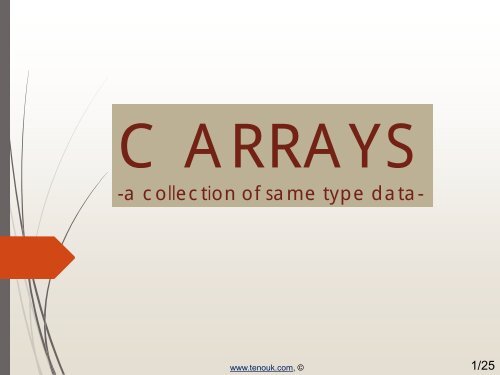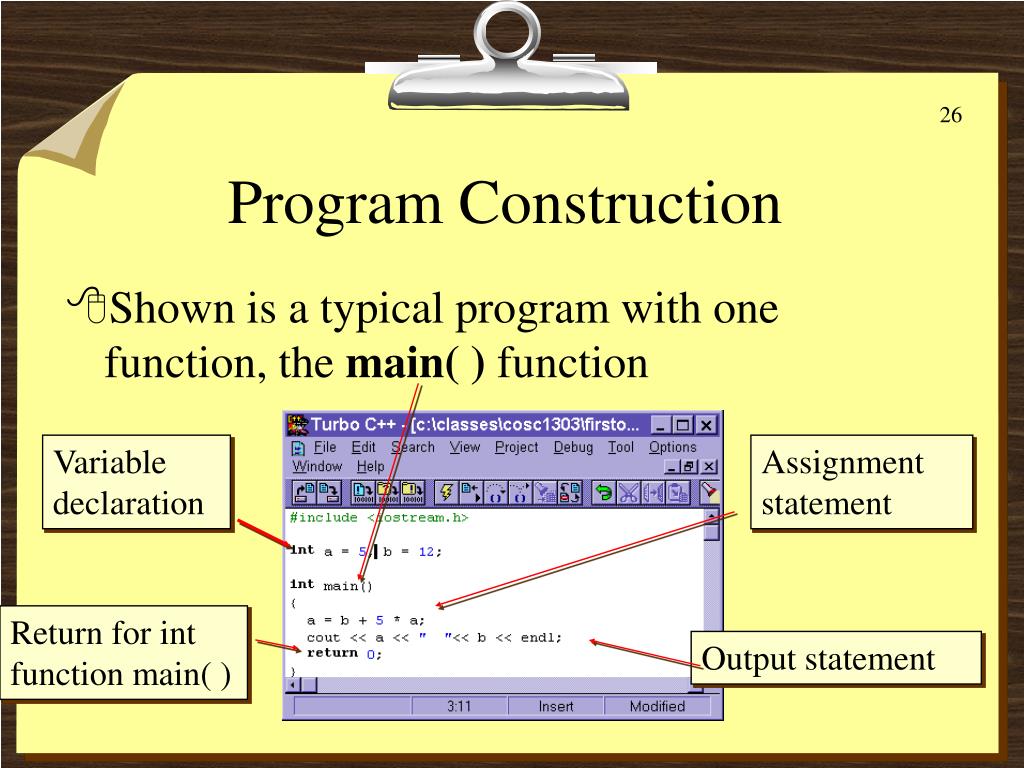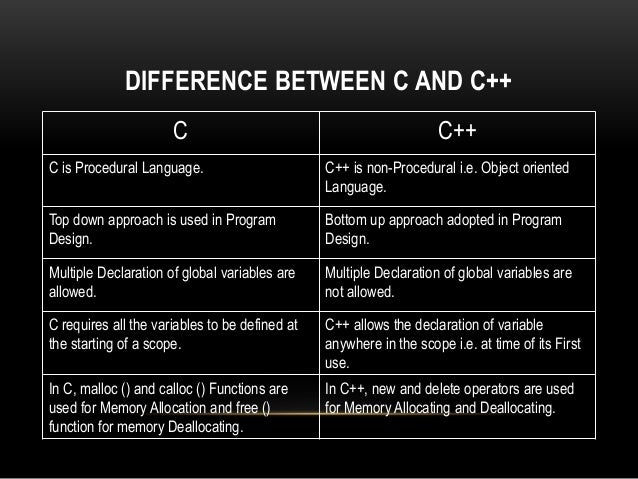Sep 01, 2011 We can also declare and define a variable in single shot like this. Int a=10; Format specifiers%d is the format specifier. This informs to the compiler that the incoming value is an integer value. The examples above, it inserted the literal string Output sentence, the number 120, and the value of variable x into the standard output stream cout.Notice that the sentence in the first statement is enclosed in double quotes (') because it is a string literal, while in the last one, x is not.
- C Programming Tutorial
- C Programming useful Resources
- Selected Reading
A union is a special data type available in C that allows to store different data types in the same memory location. You can define a union with many members, but only one member can contain a value at any given time. Unions provide an efficient way of using the same memory location for multiple-purpose.
Defining a Union

To define a union, you must use the union statement in the same way as you did while defining a structure. The union statement defines a new data type with more than one member for your program. The format of the union statement is as follows −
The union tag is optional and each member definition is a normal variable definition, such as int i; or float f; or any other valid variable definition. At the end of the union's definition, before the final semicolon, you can specify one or more union variables but it is optional. Here is the way you would define a union type named Data having three members i, f, and str −
Now, a variable of Data type can store an integer, a floating-point number, or a string of characters. It means a single variable, i.e., same memory location, can be used to store multiple types of data. You can use any built-in or user defined data types inside a union based on your requirement.
The memory occupied by a union will be large enough to hold the largest member of the union. For example, in the above example, Data type will occupy 20 bytes of memory space because this is the maximum space which can be occupied by a character string. The following example displays the total memory size occupied by the above union −
When the above code is compiled and executed, it produces the following result −
Accessing Union Members
To access any member of a union, we use the member access operator (.). The member access operator is coded as a period between the union variable name and the union member that we wish to access. You would use the keyword union to define variables of union type. The following example shows how to use unions in a program −
When the above code is compiled and executed, it produces the following result −
Here, we can see that the values of i and f members of union got corrupted because the final value assigned to the variable has occupied the memory location and this is the reason that the value of str member is getting printed very well.
Now let's look into the same example once again where we will use one variable at a time which is the main purpose of having unions −
When the above code is compiled and executed, it produces the following result −
Here, all the members are getting printed very well because one member is being used at a time.
C programs with output showing usage of operators, loops, functions, arrays, performing operations on strings, files, pointers. Download executable files and execute them without compiling the source file. Code::Blocks IDE is used to write programs; most of these will work with GCC and Dev C++ compilers. The first program, prints 'Hello World.'
C programming examples with output
Example 1 - C hello world program
/** My first C program */
int main()
{
printf('Hello Worldn');
return0;
}
Output of program:
'Hello World'
Example 2 - C program to get input from a user using scanf
#includeint main()
{
int x;
printf('Input an integern');
scanf('%d',&x);// %d is used for an integer
printf('The integer is: %dn', x);
return0;
}
Output:
Input an integer
7897
The integer is: 7897
Example 3 - using if else control instructions
#includeint main()
{
int n;
printf('Enter a numbern');
scanf('%d',&n);
Legion token aqw bot. if(n >0)
printf('Greater than zero.n');
else
printf('Less than or equal to zero.n');
return0;
}
Output:
Enter a number
-45
Less than or equal to zero.
Example 4 - while loop example
int main()
{
int c =1;// Initializing variable
while(c <=10)// While loop will execute till the condition is true
{
printf('%d ', c);// Note the space after %d for gap in the numbers we want in output
c++;
}
return0;
}
Output:
1 2 3 4 5 6 7 8 9 10
Example 5 - C program check if an integer is prime or not

int main()
{
int n, c;
printf('Enter a numbern');
scanf('%d',&n);
if(n 2)
printf('Prime number.n');
else
{
for(c =2; c <= n -1; c++)
{
if(n % c 0)
break;
}
if(c != n)
printf('Not prime.n');
else
printf('Prime number.n');
}
return0;
}
Example 6 - command line arguments
#includeint main(int argc,char*argv[])
{
int c;
printf('Number of command line arguments passed: %dn', argc);

for(c =0; c < argc; c++)
printf('%d argument is %sn', c +1, argv[c]);
return0;
}

To define a union, you must use the union statement in the same way as you did while defining a structure. The union statement defines a new data type with more than one member for your program. The format of the union statement is as follows −
The union tag is optional and each member definition is a normal variable definition, such as int i; or float f; or any other valid variable definition. At the end of the union's definition, before the final semicolon, you can specify one or more union variables but it is optional. Here is the way you would define a union type named Data having three members i, f, and str −
Now, a variable of Data type can store an integer, a floating-point number, or a string of characters. It means a single variable, i.e., same memory location, can be used to store multiple types of data. You can use any built-in or user defined data types inside a union based on your requirement.
The memory occupied by a union will be large enough to hold the largest member of the union. For example, in the above example, Data type will occupy 20 bytes of memory space because this is the maximum space which can be occupied by a character string. The following example displays the total memory size occupied by the above union −
When the above code is compiled and executed, it produces the following result −
Accessing Union Members
To access any member of a union, we use the member access operator (.). The member access operator is coded as a period between the union variable name and the union member that we wish to access. You would use the keyword union to define variables of union type. The following example shows how to use unions in a program −
When the above code is compiled and executed, it produces the following result −
Here, we can see that the values of i and f members of union got corrupted because the final value assigned to the variable has occupied the memory location and this is the reason that the value of str member is getting printed very well.
Now let's look into the same example once again where we will use one variable at a time which is the main purpose of having unions −
When the above code is compiled and executed, it produces the following result −
Here, all the members are getting printed very well because one member is being used at a time.
C programs with output showing usage of operators, loops, functions, arrays, performing operations on strings, files, pointers. Download executable files and execute them without compiling the source file. Code::Blocks IDE is used to write programs; most of these will work with GCC and Dev C++ compilers. The first program, prints 'Hello World.'
C programming examples with output
Example 1 - C hello world program
/** My first C program */
int main()
{
printf('Hello Worldn');
return0;
}
Output of program:
'Hello World'
Example 2 - C program to get input from a user using scanf
#includeint main()
{
int x;
printf('Input an integern');
scanf('%d',&x);// %d is used for an integer
printf('The integer is: %dn', x);
return0;
}
Output:
Input an integer
7897
The integer is: 7897
Example 3 - using if else control instructions
#includeint main()
{
int n;
printf('Enter a numbern');
scanf('%d',&n);
Legion token aqw bot. if(n >0)
printf('Greater than zero.n');
else
printf('Less than or equal to zero.n');
return0;
}
Output:
Enter a number
-45
Less than or equal to zero.
Example 4 - while loop example
int main()
{
int c =1;// Initializing variable
while(c <=10)// While loop will execute till the condition is true
{
printf('%d ', c);// Note the space after %d for gap in the numbers we want in output
c++;
}
return0;
}
Output:
1 2 3 4 5 6 7 8 9 10
Example 5 - C program check if an integer is prime or not
int main()
{
int n, c;
printf('Enter a numbern');
scanf('%d',&n);
if(n 2)
printf('Prime number.n');
else
{
for(c =2; c <= n -1; c++)
{
if(n % c 0)
break;
}
if(c != n)
printf('Not prime.n');
else
printf('Prime number.n');
}
return0;
}
Example 6 - command line arguments
#includeint main(int argc,char*argv[])
{
int c;
printf('Number of command line arguments passed: %dn', argc);
for(c =0; c < argc; c++)
printf('%d argument is %sn', c +1, argv[c]);
return0;
}
This program prints the number of arguments and their contents.
Example 7 - Array program
#includeint main()
{
int array[100], n, c;
printf('Enter number of elements in arrayn');
scanf('%d',&n);
printf('Enter %d elementsn', n);
for(c =0; c < n; c++)
scanf('%d',&array[c]);
printf('The array elements are:n');
for(c =0; c < n; c++)
printf('%dn', array[c]);
return0;
}
Example 8 - function program
#includevoid my_function();// Declaring a function
int main()
{
printf('Main function.n');
my_function();// Calling the function
printf('Back in function main.n');
return0;
}
// Defining the function
void my_function()
{
printf('Welcome to my function. Feel at home.n');
}
Example 9 - Using comments in a program
int main()
{
// Single line comment in a C program
printf('Writing comments is very useful.n');
/*
* Multi-line comment syntax
* Comments help us to understand a program later easily.
* Will you write comments while writing programs?
*/
printf('Good luck C programmer.n');
return0;
}
Example 10 - using structures in C programming Teamviewer portable old version downloads.
#include#include
struct game
{
char game_name[50];
int number_of_players;
};// Note the semicolon
int main()
{
struct game g;
strcpy(g.game_name,'Cricket');
g.number_of_players=11;
printf('Name of game: %sn', g.game_name);
printf('Number of players: %dn', g.number_of_players);
return0;
}
Example 11 - C program for Fibonacci series
#includeint main()
{
int n, first =0, second =1, next, c;
printf('Enter the number of termsn');
scanf('%d',&n);
printf('First %d terms of Fibonacci series are:n', n);
for(c =0; c < n; c++)
{
if(c <=1)
next = c;
else
{
next = first + second;
first = second;
second = next;
}
printf('%dn', next);
}
return0;
}
Example 12 - C graphics programming
#include#include
int main()
{
int gd = DETECT, gm;
initgraph(&gd,&gm,'C:TCBGI');
outtextxy(10,20,'Graphics programming is fun!');
circle(200,200,50);
setcolor(BLUE);
line(350,250,450,50);
getch();
closegraph();
return0;
}
How to compile C programs with GCC compiler?
If you are using GCC on Linux operating system, then you may need to modify the programs. For example, consider the following program that prints the first ten natural numbers.
#include#include
int main()
{
int c;
for(c =1; c <=10; c++)
printf('%dn', c);
getch();
return0;
}
The program includes a header file <conio.h> and calls the getch function, but this file is Borland specific, so it works in Turbo C compiler but not in GCC. The program for GCC must be like:
int main()
{
int c;
/* for loop */
for(c =1; c <=10; c++)
printf('%dn', c);
return0;
}
If you are using GCC, save the program in a file say 'numbers.c' to compile the program, open the terminal and enter the command 'gcc numbers.c', this compile the program and to execute it enter the command './a.out' do not use quotes while executing commands. You can specify the output file name as 'gcc numbers.c -o numbers.out', to run execute './numbers.out' in the terminal.
C programming tutorial
A program consists of functions that contain instructions given to a machine to perform a task. The process of writing it includes designing an algorithm, drawing a flowchart, and then writing code. After writing it, you need to test it and debug it if it does not produce the required output.
To write a program, you need a text editor (use your favorite one) and a compiler. A compiler converts source code into machine code, which consists of zero's and one's only, ready to be executed on a machine.
C++ Programs Examples With Output Ppt Examples
An IDE (Integrated Development Environment) provides a text editor, compiler, debugger, etc. for developing programs and managing projects. Code::Blocks IDE provides an ideal environment for development. It can import Microsoft Visual C++ projects, is extendable as it uses plug-ins, open-source, and cross-platform.
How to write a C program?
A program must have at least a main function. A function consists of declarations and statements. A statement is an expression followed by a semicolon. For example, a + b, printf('C program examples') are expressions and a + b; and printf('C is an easy to learn computer programming language'); are statements.
To use a variable, we must indicate its type, whether it is an integer, float, character, or others. C language has many built-in data types, and we can create ours using structures and unions. Every data type has its size that may depend on the machine; for example, an integer may be of 2 or 4 Bytes. Data is stored in a binary form, i.e., a group of bits where each bit can be '0' or '1'.
Keywords such as 'switch,' 'case,' 'default,' 'register,' are reserved words with predefined meaning and can't be used as the name of a variable or a function. Memory can be allocated at compile-time or run-time using malloc and calloc functions. C language has many features such as recursion, preprocessor, conditional compilation, portability, pointers, multi-threading by using external libraries, dynamic memory allocation. Thanks to these, it is used for making portable software programs and applications. Using networking API's users can communicate and interact with each other and share files.
C standard library contains functions for mathematical operations, characters, input/output, files, and many more. The process of writing a program known as coding requires knowledge of programming language and logic to achieve the desired output. So you should learn C programming basics and start making programs.
Learning data structures (stacks, queues, linked lists, binary trees, graphs) using C provides you a greater understanding as you study everything in detail. A general belief is to go for high-level languages. However, it's a good idea to learn C before learning C++ or Java. C++ is object-oriented and contains all features of C, so learning C help you learn C++ quickly, then you can study Java.
C programming PDF
C programming books
- Let Us C By Yashavant Kanetkar
- PROGRAMMING WITH C By Byron Gottfried, Jitender Chhabra
- The C Programming By Brian Kernighan and Dennis Ritchie
C++ Programs Examples With Output Ppt Presentations
If you are a beginner, buy any one of the first two books, and if you have previous programming experience or you know the basics of C language, buy the third one.
